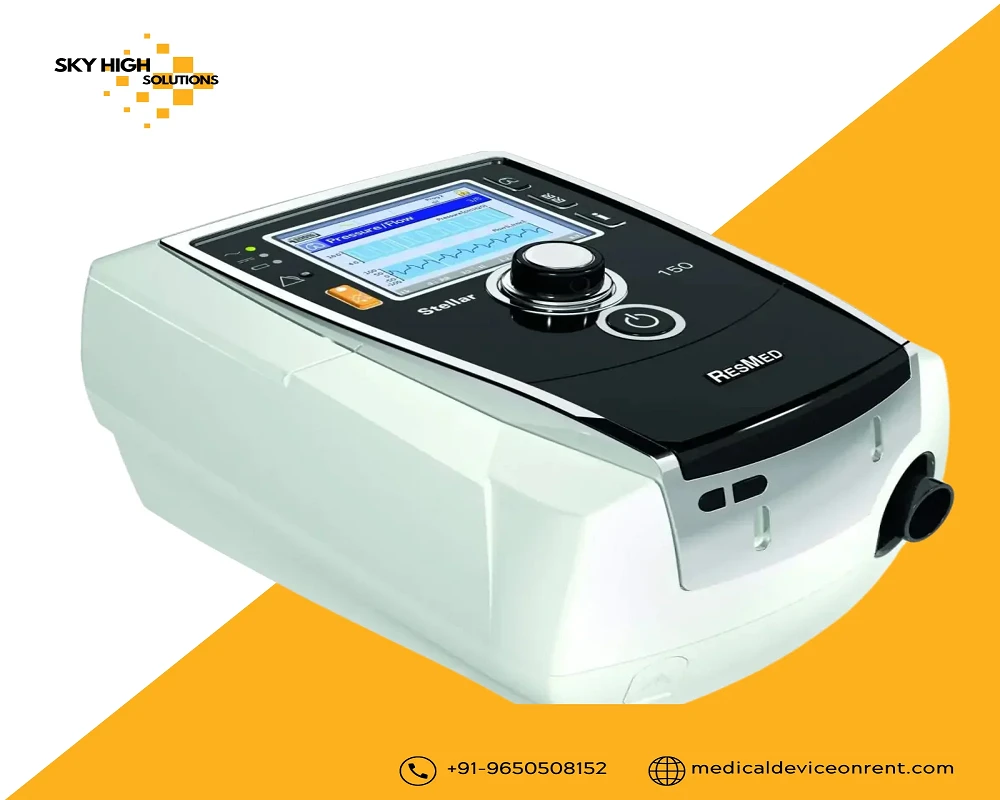Ventilators are life-saving medical devices that help patients breathe when they are unable to do so independently. They play a crucial role in modern medicine, particularly in intensive care units (ICUs), emergency rooms, and home healthcare settings. Understanding ventilators is essential for both medical professionals and patients who may need respiratory support. If you are looking for a ventilator machine for rent in Gurugram, we offer reliable solutions for home and hospital use.
Must Read: Best Oxygen Concentrator for Home Use in Delhi NCR
What is a Ventilator?
A ventilator is a machine that helps a patient breathe by delivering oxygen into the lungs and removing carbon dioxide. It supports breathing by using controlled air pressure to assist or take over the respiratory process. Unlike oxygen therapy, which only supplies additional oxygen, ventilators actively assist in breathing.
How Does a Ventilator Work?
Ventilators work by:
- Delivering a controlled flow of air and oxygen to the lungs
- Adjusting air pressure to ensure effective breathing
- Monitoring a patient’s breathing patterns and adjusting accordingly
Modern ventilators have feedback systems that continuously assess and modify airflow based on the patient’s needs.
When is a Ventilator Needed?
Ventilators are required in various medical conditions, including:
- Severe pneumonia or lung infections
- Chronic respiratory conditions like COPD
- Trauma or injury affecting the lungs
- Neurological conditions affecting breathing
- Emergency situations such as cardiac arrest or drug overdose
Patients may use ventilators temporarily during surgeries or long-term for chronic respiratory conditions.
Types of Ventilators
1. Invasive Ventilators
These ventilators require a tube inserted into the airway, either through the mouth (endotracheal intubation) or a surgically created opening in the neck (tracheostomy). They are used in ICUs for critical patients.
2. Non-Invasive Ventilators (NIV)
Non-invasive ventilators do not require an airway tube and use masks or nasal interfaces instead. Examples include CPAP (Continuous Positive Airway Pressure) and BiPAP machines. These are commonly used for conditions like sleep apnea and mild respiratory distress.
3. Portable and Home Ventilators
Portable ventilators are designed for patients who require long-term respiratory support at home. These devices are lightweight and can be battery-operated, making them suitable for mobility-restricted individuals. If you need a ventilator machine for rent in Gurugram, we provide high-quality home ventilators with expert support.
Components of a Ventilator
Key components of a ventilator include:
- Airflow system: Delivers oxygen and air mixture
- Humidifiers: Prevents dryness in the airway
- Alarms and monitoring functions: Alert caregivers to issues such as low oxygen levels or airway obstructions
Ventilator Settings and Modes
1. Volume-Controlled vs. Pressure-Controlled Ventilation
- Volume-controlled: Delivers a set volume of air per breath
- Pressure-controlled: Delivers air at a set pressure level
2. Assist-Control (AC) Ventilation
Automatically delivers breaths if a patient fails to do so, commonly used for critical care patients.
3. Synchronized Intermittent Mandatory Ventilation (SIMV)
Allows spontaneous breathing between ventilator-delivered breaths, reducing dependence.
4. Pressure Support Ventilation (PSV)
Assists with natural breathing efforts by providing additional pressure support.
The Role of Ventilators in Critical Care
Ventilators are essential in ICUs, particularly for treating patients with severe respiratory illnesses like ARDS (Acute Respiratory Distress Syndrome) and COVID-19. They help stabilize oxygen levels and improve breathing function while monitoring patient vitals continuously.
Risks and Complications of Ventilator Use
Common risks include:
- Ventilator-associated pneumonia (VAP)
- Lung damage due to excessive air pressure
- Dependency on ventilators for breathing
- Throat discomfort and speech difficulties
Weaning Off a Ventilator
Weaning involves gradually reducing ventilator support as the patient regains independent breathing. Challenges include muscle weakness and prolonged dependency, requiring respiratory therapy and rehabilitation.
Ventilator Innovations and Future Trends
Modern ventilators are advancing with:
- AI and smart monitoring systems
- Portable, user-friendly home ventilators
- Improved alarm and safety mechanisms
Must Read: Oxygen Cylinders: Types, Uses and Benefits for Medical Care
Frequently Asked Questions (FAQs)
Can a ventilator cure breathing problems?
No, a ventilator provides respiratory support but does not cure underlying conditions.
How long can a person stay on a ventilator?
It depends on the medical condition, ranging from hours to months.
Is a ventilator the same as life support?
A ventilator is a type of life support but does not replace other critical functions like circulation.
What are the signs that a ventilator is needed?
Severe breathing difficulty, low oxygen levels, or respiratory failure.
Can a ventilator be used at home?
Yes, non-invasive and portable ventilators are available for home use.
Are there any side effects of using a ventilator?
Possible side effects include lung infections, discomfort, and long-term dependency.
For more details on high-quality ventilators, check out our products:
If you are searching for a ventilator machine for rent in Gurugram, contact us today for expert guidance and support.

